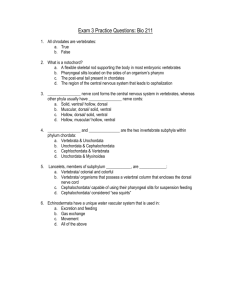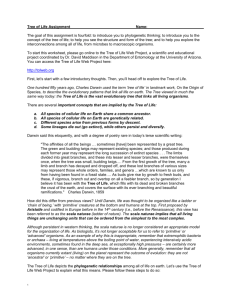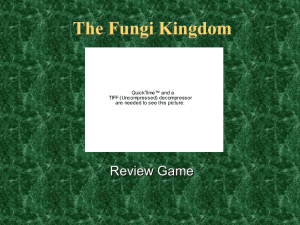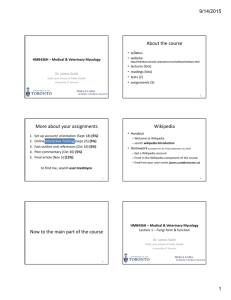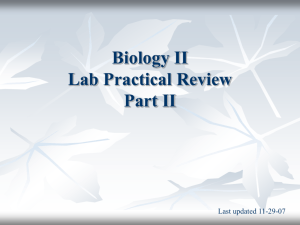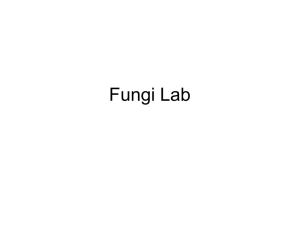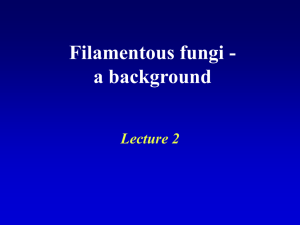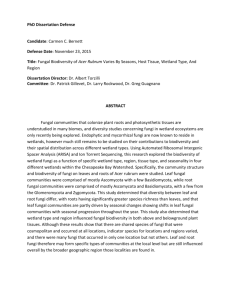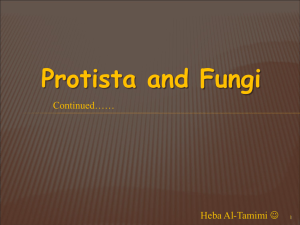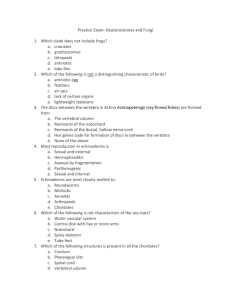Exam 3 Practice Questions ANSWERS
advertisement
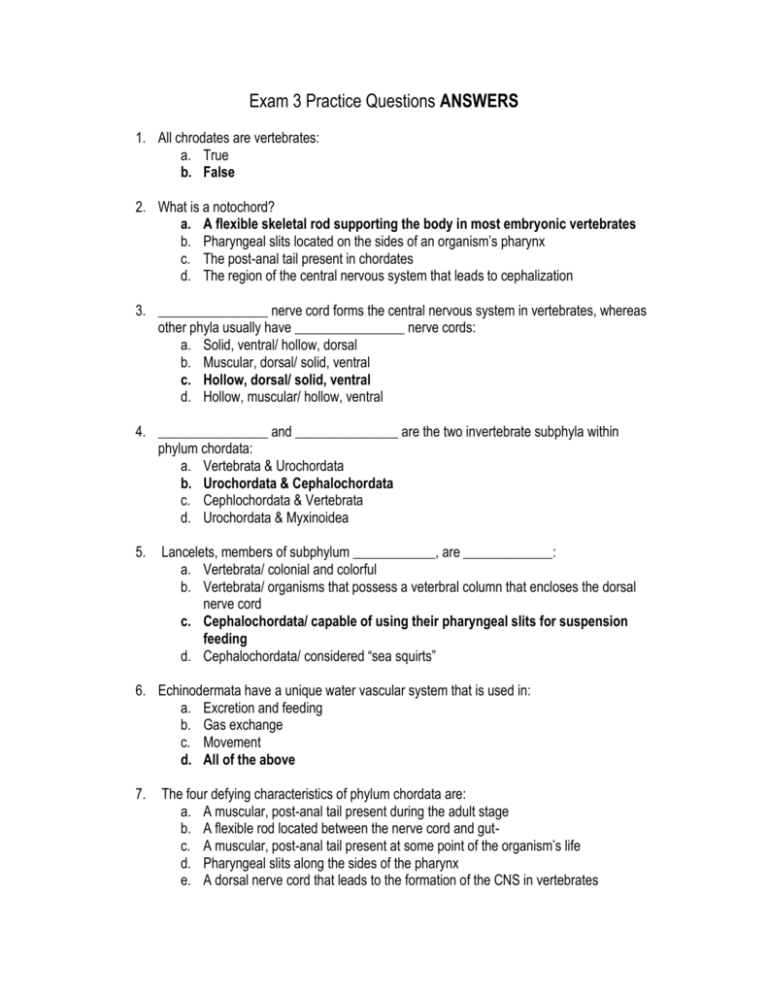
Exam 3 Practice Questions ANSWERS 1. All chrodates are vertebrates: a. True b. False 2. What is a notochord? a. A flexible skeletal rod supporting the body in most embryonic vertebrates b. Pharyngeal slits located on the sides of an organism’s pharynx c. The post-anal tail present in chordates d. The region of the central nervous system that leads to cephalization 3. ________________ nerve cord forms the central nervous system in vertebrates, whereas other phyla usually have ________________ nerve cords: a. Solid, ventral/ hollow, dorsal b. Muscular, dorsal/ solid, ventral c. Hollow, dorsal/ solid, ventral d. Hollow, muscular/ hollow, ventral 4. ________________ and _______________ are the two invertebrate subphyla within phylum chordata: a. Vertebrata & Urochordata b. Urochordata & Cephalochordata c. Cephlochordata & Vertebrata d. Urochordata & Myxinoidea 5. Lancelets, members of subphylum ____________, are _____________: a. Vertebrata/ colonial and colorful b. Vertebrata/ organisms that possess a veterbral column that encloses the dorsal nerve cord c. Cephalochordata/ capable of using their pharyngeal slits for suspension feeding d. Cephalochordata/ considered “sea squirts” 6. Echinodermata have a unique water vascular system that is used in: a. Excretion and feeding b. Gas exchange c. Movement d. All of the above 7. The four defying characteristics of phylum chordata are: a. A muscular, post-anal tail present during the adult stage b. A flexible rod located between the nerve cord and gutc. A muscular, post-anal tail present at some point of the organism’s life d. Pharyngeal slits along the sides of the pharynx e. A dorsal nerve cord that leads to the formation of the CNS in vertebrates f. A, C, D, and E g. B, C, D, and E h. B, D, and E 8. Members of subphylum Vertebrata different from subphylum Urochordata in that: a. Urochordata possess a notochord, a nerve cord, and a tail while Vertebrata do not b. Urochordata are chordates with a cartilaginous skull while the Vertebrata have bony skulls c. Vertebrata include the hagfish that lack a vertebral column while Urochordata possess a vertebral column that encloses the dorsal nerve cord d. Vertebrata posses all the chordate characteristics while having pronounced cephalization and a vertebral column while larvae in Urochordata are freeswimming and possess a nerve cord 9. All of the following are major events in vertebrate history EXCEPT for: a. adapting to reproducing on land b. development of a bony endoskeleton c. having free-swimming larva d. producing more complex excretory and circulatory system e. All of the above are major events f. A, B, and D g. A, B, C, and D 10. Which of the following are INCORRECTLY paired together? a. Actinopterygii = skates, rays, and sharks b. Chondrichthyes = hag fish c. Amphibians= salamanders, frogs, and toads d. Amniotes = vertebrate animals without an aquatic larval stage e. B and D f. A and D g. A and B 11. In addition to possessing all of the vertebrate and chordate characteristics, all mammals are capable of doing/ posses the following: 1) Enlarged skulls 2) Have hair 3) Highly specialized teeth 4) Lactation 12. Amphibians are known for undergoing internal fertilization and lay their eggs in swamps, ponds, and other moist places a. True b. False 13. Which of the following is considered an amniote? a. Alligators & crocodiles b. Frogs c. Lancelets d. Turnicates 14. In your own words, what is so advantageous about possessing an amniotic egg? Allows organism to complete their life cycles on land (mammals and reptiles) 15. Match the following with the correct terms: 1) Bats a. Monotremes: 6, 3 2) Possess an organ that connects b. Marsupials: 4, 5 the developing embryo to the c. Eutherians: 1, 2, 7, 8 mother’s uterine wall 3) Duck-billed platypus 4) Koalas 5) Pouched mammals 6) Egg-laying mammals 7) Humans 8) Whales 16. Which of the following is NOT a member of class Reptilia? a. Snakes b. Salamanders c. Birds d. Turtles 17. Define the following terms: a. Hyphae: long branching filaments found in fungi; have nuclei and mitochondria b. Septa: indivudal compartmentalized cells within septa; pores present for cell-cell communication c. Coenocytic hyphae: hyphae that lack septa d. Mycelium: large bunch of hyphae 18. All fungi are _____________ and acquire their nutrients by absorption: a. chemoautotrophs b. photoheterotrophs c. photoorganoheterotrophs d. chemoorganoheterotrophs 19. The five primary phylums of kingdom fungi are as follows: a. Microsporidians b. The “sac” fungi: Ascomycota c. The “club” fungi: Basidiomycota d. 80% of all plants have a mycorrhizal relationship with members of this phylum: Glomeromycota e. Some members of this polyphyletic group undergo alternation of generations, while others produce a their 2n zygotes within a zygosporangium: Chytirds & zygosporangium 20. The production of a flagella are unique to group __________ because of _______: a. Ascomycota/ their mutualistic relationships with plants b. Ascomycota/ their cell walls c. Chytrids/ living in primarily aquatic environments d. Chytrids/ their ability to be parisites to amphibians 21. Define the following: a. Endomycorrhizae: Fungi physically integrate within plant root (some can form arbuscular mycorrhizae) b. Ectomycorrhizae: fungal association with vascular plants that remain outside of the roots 22. Plasmogamy is: a. The fusion of two or more nuclei without the fusion of the plasma membranes/ cytoplasmic contents b. The fusion of two or more fungi c. The fusion of two or more gametes unique to fungi d. The fusion of two or more plasma membranes/ cytoplasmic contents without the fusion of nuclei 23. Basidiomycota primarily reproduce sexually, whereas Ascomycota heavily rely on their conidia, or asexual spores, for reproduction. a. True b. False 24. Because fungi are more closely related to eukaryotes, they too possess male and female gametes. a. True b. False 25. The __________, which are the tips of the ________________, are formed largely of dikaryotic hyphae where meiosis occurs: a. basidia/ basidiocarps b. sacs/ ascocarps c. asci/ glomeromycota d. basidia/ zygotes 26. Meiosis produces _____________, while mitosis produces _____________: a. 4 genetically identical haploid cells/ 2 genetically identical daughter cells b. 4 genetically distinct haploid cells/ 2 genetically identical daughter cells c. 2 genetically identical diploid cells/ 4 genetically identical daughter cells d. 2 genetically distinct diploid cells/ 4 genetically distinct daughter cells 27. You see that a tree has fallen while walking through the forest. 2 weeks later, you see that the same tree has been decomposed significantly. To what phylum would you expect to classify this fungi within? a. Ascomycota b. Glomeromycota c. Basidiomycota d. Zygomycota 28. Morels are members of phylum basidiomycota. a. True b. False (Ascomycota) 29. Yeasts are ___________ and bud asexually. a. unicellular members of Ascomycota b. unicellular members of lichens c. multicellular members of glomeromycota d. multicellular members of Ascomycota 30. Lichens are able to perform photosynthesis because of their mutualistic associations with: a. Algae b. Cyanobacteria c. Vascularized plants d. Both A and B (*note that the fungi found in lichens are usually members of phylum Ascomycota) 31. List and describe the characteristics of the three morphological forms of lichen: a. Foliose: look like leaves b. Fruticose: branching tree c. Crustose: tightly pressed to their surface; small; most common form 32. Asexual reproduction of lichens usually results in the production of __________ which grow into genetically ____________ versions of their parents: a. Soredia/ distinct b. Soredia/ identical c. Conidia/ distinct d. Conidia/ identical (SEE PAGE 626 IN YOUR TEXTBOOK FOR FUNGI SEXUAL REPRODUCTIVE LIFE CYCLES. You will need to know these well!)
